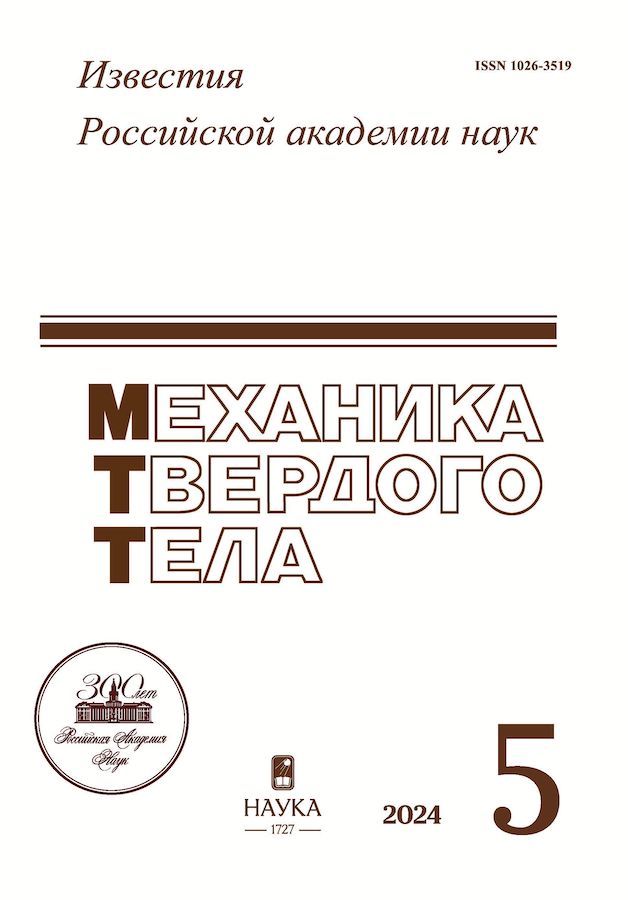Description of the phenomenon of decreasing plasticity with increasing yield strength of polycrystal
- Autores: Marina V.Y.1
-
Afiliações:
- Technical University of Moldova
- Edição: Nº 5 (2024)
- Páginas: 138–163
- Seção: Articles
- URL: https://archivog.com/1026-3519/article/view/672978
- DOI: https://doi.org/10.31857/S1026351924050091
- EDN: https://elibrary.ru/UAPTCL
- ID: 672978
Citar
Texto integral
Resumo
Using a three-level constitutive model, the influence of the crystal anisotropy factor, the hardening coefficient, the microscopic elastic limit and the distribution density function of the limiting elastic deformations of subelements on the shape of the deformation diagrams and the fracture conditions of a polycrystal is studied. Based on the theory of maximum normal stresses at the local level, a failure criterion was established at the macroscopic level, which includes all the parameters of the problem. The influence of the type of stress state and the geometric shape of the loading diagram on the magnitude of irreversible deformation preceding the initial process of destruction is investigated. From the established strength criterion follows the effect of a decrease in the plasticity of the material with increasing yield strength. The question of the critical value of the weight of destroyed subelements is discussed, at which a macrocrack forms, leading to the complete destruction of the body element.
Palavras-chave
Texto integral
Sobre autores
V. Marina
Technical University of Moldova
Autor responsável pela correspondência
Email: vasilemarina21@yahoo.com
Moldova, Chisinau
Bibliografia
- Ilyushin A.A. Continuum mechanics. M.: Moscow State University Publishing House, 1990. 310 p.
- Novozhilov V.V., Kadashevich Yu.I. Microstresses in structural materials. L.: Mechanical Engineering, 1990. 223 p.
- Shevchenko Yu.N., Terekhov R.G. Physical equations of thermoviscoplasticity. Kyiv: Naukova Dumka, 1982. 238 p.
- Makarov V.P. Modeling of deformation and fracture processes at the mesolevel // Izv. ANR. MTT. 1999. No. 5, P. 109–130.
- Trusov P.V. Classical and multi-level constitutive models for describing the behavior of metals and alloys: problems and prospects (in order of discussion) // Izv. ANR. MTT. 2021. No. 1. P. 69–82. https://doi.org/10.31857/S0572329921010128.
- Marina V.Yu. and Marina V.I. Single Approach to the Description of the Relation Between Micro-and Macrostates in Reversible and Irreversible Deformation of Polycrystals. International Applied Mechanics, Vol. 57, No. 6, P. 707-719. 2021. https://doi.org/10.1007/s10778-022-01120-x.
- Besseling J.F. Theory of elastic, plastic and creep deformations of an initially isotropic material showing anisotropic strain-hardening, creep recovery and secondary creep // Journal of Applied Mechanics. 1958. No. 4. P. 529–536.
- Gokhfeld D. A., Sadakov O. S. Plasticity and creep of structural elements under repeated loading. M.: Mechanical Engineering, 1984. 256 p.
- Marina V.Yu., Equations of an elastoplastic body under proportional non-isothermal loading //Applied mechanics. 1997. No. 6. P. 9–17.
- Marina V.Yu., Marina V.I., Analysis of the relationships between local and general mechanical parameters used to describe the behavior of polycrystalline materials. //Metallophysics. Newest Technologies. 2020. V. 42. No. 3. P. 415–431. https://doi.org/10.15407/mfint.42.03.
- Kroner E. On the physical reality of torque stresses in continuum mechanics Gauge theory with dislocations. – Inst. I.Engng. Sci 1. 1963. P. 261–278.
- Shermogor T.D., Theory of elasticity of micro-inhomogeneous media. M.: Nauka, 1977. 400 p.
- Flipona B., Kellera C., Queyb R., Barbea F. A Full-field Crystal – Plasticity Analysis of Bimodal Polycrystals // International Journal of Solids and Structures 184, 2020. P. 178–192.
- Tanaka E., Murakami S., Ooka M. Effects of strain path shapes on nonproportional cyclic plasticity//J. Mech. Phys. Solids. 1985. Vol. 33. No. 6. P. 559–575.
- Kadashevich Yu.I., Marina V.Yu., Pomytkin S.P. On one trend in the development of the static theory of inelasticity, taking into account microstresses // Izv. ANR. MTT. 1998. No. 1, P. 13–18.
- Marina V.Yu. Nonlocal approach to the problem of irreversible deformation of an inhomogeneous body. Numerical studies in continuum mechanics. Chisinau: Shtiintsa, 1987. P. 47–53
- Marina V.Yu. A unified approach to describing the rheological properties of stable and unstable materials. Numerical methods for solving problems of wave dynamics. Chisinau: Shtiintsa, 1990. P. 76–85.
- Marina V.Yu. Constitutive equations of a micro-inhomogeneous medium under complex monotonic loading//Proceedings of the Academy of Sciences of Moldova. Mathematics series. 1997. No. 2. P. 26–36.
- Marina V.Yu. Patterns of changes in the limiting values of stress and strain invariants in micro-inhomogeneous media // Izv. ANR. MTT. 2023. No. 3, P. 127–152. https://doi.org/10.31857/S0572329922700015.
- Hill R. The elastic behavior of a crystalline aggregate. Proc. Soc. 1952. A 65, no. 389. P. 349–354.
- Marina V.Yu. Principles of transition from micro to macro stress-strain state//News of the Academy of Sciences of Moldova. Series mathematics, 1998. No. 2. P. 16–24.
- Voigt W. Lehrbuch der Kristallphysik. – Leipzig und Berlin: Teubner, 1928. 978 s.
- Reuss A. Berechnung der Fliesgrenze von Misch-Kristallen auf Grund der Plastizitats-Bedinnung für Einkristalle // Zeitschrift für Angewandte Mathematik und Mechanik. Bd. 9. – H. 1. 1929. P. 49–58.
Arquivos suplementares

















